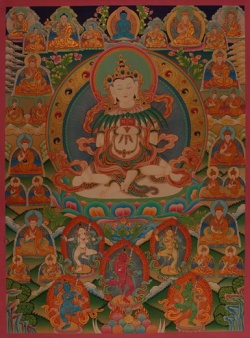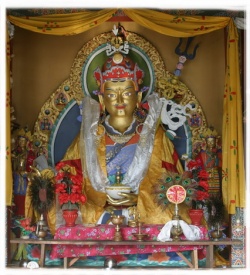Types of Buddhism and their Development in the West
(A slightly amended text written for the AQA syllabus by Robert Ellis, formerly a member of the Triratna Buddhist Order and a former Head of RS in a 6th-form college.)
The focus in this section is mainly on Buddhism in the West and the way that Buddhism has adapted to Western conditions. However, to understand this fully it will also be necessary to look further at some schools of Buddhism in the East to compare their Eastern and Western forms.
By 'The West' throughout, we shall mean the developed countries of Europe, North America and Australasia, with particular focus on the UK. 'The East', on the other hand, is a shorthand term for the traditionally Buddhist countries of Southern and Eastern Asia. It is worth pointing out that this is purely a matter of convention, and that who is West or East of whom depends on which way round the globe you go!
The Development of Buddhism in the West
The spread of Buddhism to the West
Although the Ancient Greeks undoubtedly had contact with Buddhism, all through the Middle Ages and beyond, the West was almost totally ignorant of it. One of the saints in the Roman Catholic list is St Josaphat, believed to be a corruption of 'Bodhisat', and the stories about him bear a vague resemblance to those of the Buddha (see Catholic Encyclopedia under “Barlaam and Josaphat”). It was only in this heavily filtered and misunderstood form that stories of the Buddha made their way to medieval Europe.
Two hundred years ago, not only were there no Buddhists whatsoever in the West, but few even amongst educated or travelled people would recognise the term. There was very little understanding of what linked the Asian religions that stretched from Sri Lanka to Japan. Although stories about the Buddha were vaguely known, he was thought to be a god and there was no knowledge of a historical Buddha. No Buddhist texts had been translated into any European language.
Today, Buddhism is recognised as one of the great world religions throughout the West. All the most important texts have been translated, and there are Western scholars with detailed knowledge of the scriptural languages. Buddhist art and practices such as meditation are widespread. Buddhism is researched and taught at Western universities and also taught in some schools. Although the numbers of committed Buddhists still form a very small proportion of the population (perhaps about a quarter of 1%), the influence of Buddhism is spread much more widely than this, and continues to grow.
Of course, one could still argue that Buddhism is still widely misunderstood and fairly marginal in Western society. But nevertheless, the contrast between these two situations is astonishing. Given that a religion has to be recognised, known, understood and accepted before it can go as far as making converts, and that there is enormous resistance to Buddhism from other religions and from secular society, Buddhism has come a very long way in a relatively short time.
Overall reasons for the spread
Some of the major reasons for this are as follows:
The development of Oriental Studies, which created basic knowledge of Buddhism in the West
The development of competing forms of Christianity after the Reformation, which enabled an atmosphere of religious tolerance and individual religious choice to develop in the West
The declining influence of Christianity in the West, given the impact of science and humanism
European colonialism in Asia, which put Europeans in contact with Asian culture (especially the British with India)
The development of the “New Age” movement, which is hospitable to Buddhism and has helped people be receptive to it
The usefulness of techniques of meditation and martial arts in the modern West
The Chinese invasion of Tibet, creating a “Tibetan diaspora” of exiled lamas abroad
The efforts of certain key teachers in “translating” Buddhism into a form that can be readily understood and used by Westerners
We will be investigating some of these reasons in more detail in the rest of this section. Before we do this it is also worth noting one of the major reasons which is absent in the case of Buddhism which largely accounts for the spread of Islam, Hinduism and Sikhism in the West during the same time period. The spread of Buddhism is not due very much to immigration to the West from Buddhist countries. Although there are a few traditional Thai, Vietnamese, Korean and Chinese Buddhists in the West, particularly in the United States and Australia, this ethnic minority Buddhism has had very little connection with the spread of Buddhism among the native inhabitants of Western countries.
Discussion
Why do you think that Buddhism (in contrast to, say, Islam) has spread and gained influence more through native Western populations than through ethnic minorities?
Oriental Studies
One of the most basic conditions allowing the understanding of Buddhism to develop in the West to start with has been the rise of Oriental Studies. This was the academic study of oriental cultures, including those of India, China, Japan, and other countries, by Westerners. This has included study of languages and texts, archaeology and anthropology.
Oriental Studies was pioneered by figures like Sir William Jones, who was a British judge in Calcutta in the late eighteenth century, one of the first British people to take a genuine interest in Indian culture. In China and Japan Oriental Studies was pioneered by missionary Jesuits who realised that in order to convert the natives of those lands, it was first essential to understand their view of the world. During the nineteenth and twentieth centuries these studies developed to such an extent that today many (though not all) British and American universities offer Oriental Studies courses of some kind, and an entire institution, the School of Oriental and African Studies in London, is devoted to them.
Some key figures in Oriental Studies for the understanding of Buddhism:
Max Müller, Sanskritist: developed the understanding of Hindu and Buddhist scriptural languages
Sir Alexander Cunningham, archaeologist: first realised that the Buddha was a historical figure
Eugene Burnouf, philologist: the first European academic to identify “Buddhism” as a religion and subject of study
Alexander Csoma de Körös, Tibetan scholar: a Hungarian who was the first European to study and translate Tibetan texts
T.W. Rhys-Davids and Mrs T.W. Rhys-Davids: founders of the Pali Text Society devoted to translating Pali scriptures (which still exists), and translators of many texts from the Pali Canon
Arthur Schopenhauer: The first Western philosopher to take Hindu and Buddhist ideas seriously and incorporate them into his philosophy
Research
Choose one of the above figures and research them further, using Stephen Batchelor’s Awakening of the West or the internet. Write a brief summary on their contribution to the Western understanding of Buddhism.
The first Western Buddhists
Even during the nineteenth century scholarly investigation of Buddhism, however, it did not occur to any of the investigators to actually practise Buddhism. Most of the scholars would have thought of themselves as at least loosely Christian and would not have dreamed of changing their religion. They were practising science in investigating Buddhism from what they took to be an objective standpoint, and religious participation would be taken to undermine the objectivity of the investigation. These kinds of attitudes linger to this day amongst many scholars of Buddhism in universities.
The only actual serious Western convert to Buddhism recorded before the late nineteenth century was the former Jesuit missionary Christavao Ferreira, who may have been a forced convert to Buddhism in Japan during the seventeenth century. However, the next converts, Madame Blavatsky and Colonel Henry Steel Olcott, revealed the beginning of a new tendency. Founders of the theosophists, a universalist group who tried to find truth in all religions but singled out Buddhism for special praise, Blavatsky and Olcott were the first Europeans to publicly take the Refuges and Precepts in 1880. Olcott encouraged a revival of confidence among Buddhists in British occupied Sri Lanka, which led to a number of monks gaining Western education and some other Westerners becoming Buddhists.
In 1902, the first Englishman was ordained as a Buddhist monk: this was Allan Bennett, who received the name of Ananda Metteyya. Although he returned to England from Sri Lanka, though, he was not really able to do very much to spread Buddhism in England.
In 1924 came the foundation of the Buddhist Society in London, by Christmas Humphreys, a high court judge. The Buddhist Society was not aligned to any one school of Buddhism, but tended to be Theravada in flavour. Many of its members thought of themselves as Buddhists, but many were of an armchair variety who were mainly interested in discussing the ideas rather than meditating or changing their lifestyle. The Society survives to this day.
The Sixties
It was only really in the 1960’s that more actively Buddhist organisations began to emerge in the West. It was at this point that new freedoms began to open up for young people in the Western democracies: they were able to experiment with different beliefs and lifestyles, and also to travel. This coincided with the arrival of Buddhist teachers in the West, especially Tibetan lamas fleeing the Chinese invasion of Tibet in 1961. Other new teachers, such as the Englishman Sangharakshita and the German Lama Anagarika Govinda, were returning from a self-imposed exile in the East.
At this point Buddhism became one of the influences on the New Age movement. Various famous hippies and beatniks experimented with Buddhism, such as Jack Kerouac (author of “The Dharma Bums”) and Allan Ginsberg (poet). Anti-establishment figures like Timothy Leary, the LSD pioneer, drew parallels between drug experience and meditational experience. Many hippies took the road to India, many overland in various battered vehicles, and congregated in Kathmandu, Dharamsala or Goa in search of enlightenment. Some of these eventually encountered Buddhism. There was much enthusiasm for Buddhism at this time, but little order or discipline, and much woolly thinking.
Out of this, however, emerged individuals and organisations who took Buddhism much more seriously and were determined to live their whole lives by its precepts. The new Buddhist organisations can be divided between those which imported an established Eastern form of Buddhism into the West, and those which attempted to start a new, distinctively Western form of Buddhism.
Traditional forms of Buddhism in the West
Perhaps the most popular of the traditional forms of Buddhism was Zen. Under the impact of western popularisers like Alan Watts, Zen changed from being the austere and deeply ceremonial religion it often is in Japan, to a religion of spontaneity and instant realisation. The simplicity of Zen practice made it easily compatible with Western lifestyle, and the teaching that we simply have to realise that we are already enlightened was often understood to cut out the hard work involved in Buddhist practice. Those who tried to practise Zen seriously then found that this was a misunderstanding, and that the spontaneity of Zen is created through much hard work.
Zen also became popular through its links with martial arts such a judo and taekwondo, and the Zen aesthetic, expressed in Japanese rock gardens and tea ceremonies, also became popular in the West. There were also more scholarly, but still enthusiastic, communicators of Zen to the West like D.T. Suzuki and Christmas Humphreys. Zen monasteries were founded in the West, of which the most famous in this country is probably Throssel Hole Priory in Northumberland.
Tibetan Buddhism also became popular in the West through the efforts of exiled lamas. Some of the most important of these have been Chögyam Trungpa (a gifted but controversial teacher), Lama Yeshe, and Geshe Kelsang Gyatso. Trungpa and Yeshe founded Samye Ling, a Tibetan monastery in the border area of Scotland, but Trungpa then disrobed and married and went to the United States, where he founded several new organisations. Geshe Kelsang Gyatso founded the Manjushri Institute in Cumbria, which has become the headquarters of the New Kadampa Tradition (NKT), an exclusive group in the tradition of one particular school of Tibetan Buddhism, which has spread rapidly through the UK and become the most numerous Tibetan group.
The Theravada has also been represented through the foundation of a number of Thai and Burmese monasteries in the West. One of the first of these in the UK was the London Buddhist Vihara, founded by Hammalawa Saddhatissa in 1954. Amaravati in Hertfordshire and Chithurst in Sussex followed, founded by the Thai teacher Ajahn Chah. These monasteries depend on lay support in the traditional fashion, which they gain through a combination of support from the Thai community in the UK and Western converts who might, for example, go to the monastery to learn meditation. These monasteries now contain a mixture of Thai (sometimes Burmese) and Western monks.
Two Japanese devotional schools have also found their way into the West. The Pure Land school is mainly represented by people of Chinese and Japanese origin particularly in the United States. In the UK it was promoted through the mid-20th century by the Reverend Jack Austin, originally a Soto Zen priest, who was ordained in the Jodo Shinshu tradition in Japan in 1977 and founded the Shin Buddhist Association of Great Britain. The other devotional school is Nichiren Shoshu, which is focused on devotion to the Lotus Sutra and recitation of a mantra which means 'homage to the Lotus Sutra': nam myoho rengye kyo. A combination of simplicity of practice and flexibility in trying to make use of worldly motives has helped Nichiren Shoshu spread quickly in the West and gain some famous supporters, such as pop stars.
At the same time, from the sixties, others were taking a more radical route: attempting to establish a new form of Buddhism more directly suited to Western conditions. There were two early attempts at this, a 'Western Buddhist Order' (different from the recent one) set up in 1951 by Robert Clifton, and the Scientific Buddhist Association set up by Gerald du Pre and Paul Ingram. Neither of these have gained very much support, and the first Western Buddhist Order has now long died out. However, in the Sixties two Westerners who had each spent much time in the East, studying and practising Buddhism, returned to Europe and each tried to begin a new Western form of Buddhism. These two figures were Lama Anagarika Govinda and Sangharakshita. Govinda founded the Arya Maitreya Mandala, but again this is a very small organisation. It is Sangharakshita who has had the most success.
Sangharakshita, an Englishman from London originally called Dennis Lingwood, spent twenty years in India, ordained first as a Theravada monk and then increasingly adopted Mahayana practices whilst living in contact with Tibetan lamas in the town of Kalimpong on the northern frontier with Tibet. He came to believe that a Buddhist practitioner who had understood the core principles of Buddhism could make use of a wide range of practices from the whole Buddhist tradition, so he refused to confine his loyalties to one school. On returning to the UK, he at first tried to work with the Buddhist Society, but got into too much conflict with them and decided to form his own organisation. Thus in 1968, the Western Buddhist Order (distinct from Clifton’s version - and now known as the Triratna Buddhist Order, TBO) and the Friends of the Western Buddhist Order (now known as Triratna Buddhist Community, TBC) began.
The TBO is not a monastic order, but has a membership who are publicly acknowledged as effectively committed Buddhists despite leading a wide variety of lifestyles. The TBC has succeeded in making Buddhism more accessible to Westerners by teaching two simple core meditation practices and stressing the spiritual value of friendship and of individual cultural development within a western setting. It has also dropped the hierarchical power structure of traditional Eastern schools and has become increasingly decentralised. At the same time it has stressed the value of creating contexts for serious Buddhist practice: communities, right livelihood businesses, retreat centres and urban Buddhist centres. It has now spread to many parts of the world and throughout the UK.
Discussion
Why do you think Buddhism has developed these two different forms in the West, rather than simply importing Eastern schools or simply adopting a Western form of Buddhism?
Further Reading
Cush p.154-160
Peter Harvey An Introduction to Buddhism p.300-321
Batchelor The Awakening of the West
James Coleman The New Buddhism
Past questions on AQA syllabus:
Consider the factors which have contributed to the establishment of various forms of Buddhism in the West.
Outline the establishment of Buddhism in the West, and assess the claim that Buddhism is popular in the West because it contrasts so much with the Western way of life.






